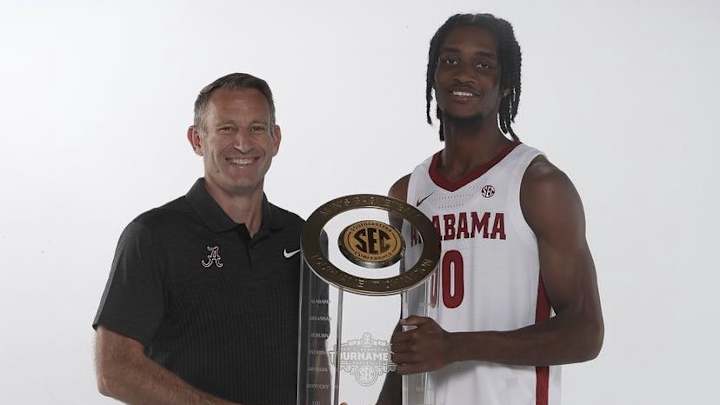Alabama Basketball Newcomer Breakdown: Kris Parker

In this story:
This is the eighth in a multi-part series where BamaCentral's Blake Byler will crunch the numbers and break down the film to give you everything you need to know about each of Alabama basketball's newcomers.
With the transfer portal making it easier and easier to find instant-impact additions to a college basketball team's roster over a single offseason, it's going to become less likely to see freshmen get immediate playing time.
When analyzing incoming freshmen, such as Alabama's Kris Parker, it's important to look at their skillsets and potential in order to consider how they may develop as contributors in the future. Parker was one of a 5-man recruiting class joining Nate Oats and company in Tuscaloosa for the 2023-24 season, and while it's hard to envision him capturing a starting role off the bat, he has some fascinating skills and tools that give him enticing potential as a player.
Parker hails from Tallahassee, Florida, where he played high school basketball in the 2A division at Crossroad Academy. His senior year at Crossroad, he stuffed the stat sheet averaging 24.8 points, 14.2 rebounds and 7.1 assists on his way to being named the Florida 2A Player of the Year.
He was rated a 4-star prospect and a consensus top-100 recruit. He was listed at 170 pounds coming out of high school, but Alabama strength coach Henry Barrera has since posted on social media that Parker has gained nearly 16 pounds since arriving on campus, which would put him in the mid-180's.
In addition to his added weight, Parker has apparently hit a growth spurt as of late. He was listed at 6-foot-6 coming out of high school, but according to the Alabama official roster, he's shot up all the way to 6-foot-9. His height to go along with his exceptionally long wingspan give him a uniquely rangy frame that looks like any basketball player's dream.
His frame gives him the tools to be a great defender, with the ability to clog passing lanes with ease and affect the shots of smaller defenders with his athleticism as well. Offensively, Parker has a distinct trait that sticks out every time he takes the floor: his ability to make difficult shots.
Parker has a remarkably high release point on his shot, which allows him to get it off without issue over smaller defenders, even when they are contesting. He has consistent feet when setting up his shot, which is why he isn't bothered by what appears to be off-balance looks.
Parker gets a smaller defender on him in the first clip after the defense switched a screen, so Parker just walked him down to the short corner and pulled up for a mid-range look, which ended up actually being over two defenders.
In the second clip Parker gave his defender a quick hesitation to slow him down for a split second, and then dribbled into an easy pull-up just inside the 3-point line.
Obviously, these are both mid-range looks, and that's usually considered a no-go in Oats' offensive system. The common misconception, though, is that Oats' philosophy prohibits the mid-range altogether. The reality, is that Oats prefers the mid-range only be taken by players who are efficient enough to make the shot worth it in his offense.
Parker's ability to hit contested shots from 12-18 feet is a valuable commodity, and his high school film suggest he is proficient enough at the skill for it to be utilized in the Alabama offense, especially if the team needed a quick bucket in a late-clock situation.
But fear not, Parker has a capable 3-ball as well:
Parker isn't considered a sniper from beyond the arc, but across his career he has steadily improved his 3-point shot to a highly respectable level.
Both of these clips showcase Parker's ability to hit tough shots from distance and not just in the mid-range, with the first play showing a smooth pull-up off a crossover and the second play showing a hesitation pull-up where he had limited space but simply rose higher than the defender to take the shot.
Parker's can create mismatches with smaller defenders because of his high release point, and it makes him an especially unique shot creator who doesn't have to rely on others getting him the ball for a catch-and-shoot.
But he still has the ability to knock down catch-and-shoot looks, which will be common in Alabama's hyper-fluent offense that revolves around the drive-and-kick. The play below shows Parker working around screens off the ball to find some open space and draining the 3-point attempt.
The question with Parker is whether or not he can crack the rotation in his first year in Tuscaloosa, and at first glance, it seems like an uphill battle.
Playing on the wing, the competition is stiff with the return of Rylan Griffen as an all-but-confirmed starter, as well as the 4-man transfer class brought in that will eat up a large portion of the minutes freed up by the roster turnover. Parker's biggest competition for minutes may come from fellow freshman Sam Walters, who has a unique skillset of his own.
Oats will always play guys that hustle and defend, so if Parker can prove to be a positive on that end of the floor, combined with his shotmaking abilities, he could find his way into a reserve role in year one.
Even if he doesn't, a year getting acclimated to the college game as well as time in the strength program will set him up to be a major contributor for the Crimson Tide in the future.
See also:
Alabama Basketball Newcomer Breakdown: Mouhamed Dioubate

Blake Byler is a staff writer for BamaCentral and primarily covers Alabama basketball and football. He has covered a wide variety of Crimson Tide sports since 2021, and began writing full-time for BamaCentral in 2023. You can find him on Twitter/X @blakebyler45.
Follow blakebyler45